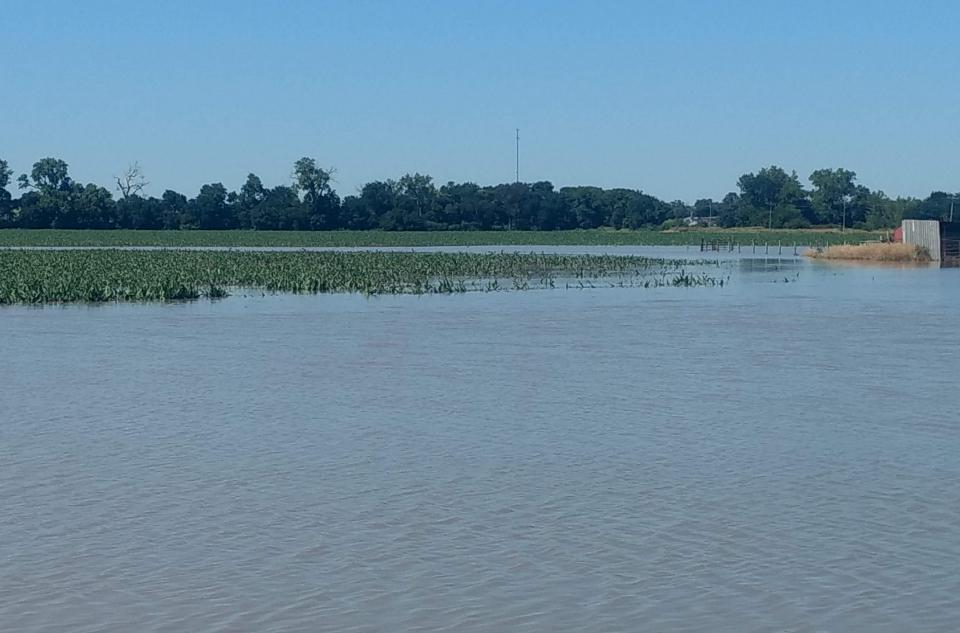
Crop Impacts and Options After Mid-Season Flooding
Also see:
Several areas in south-central and central Nebraska encountered severe storms this week. Rainfall reports ranged from 3 inches to 10+ inches of rainfall overnight. Some areas fared relatively well, while others are still waiting for waters to recede to assess the damage.
Now, the question for some producers is: How long will the crop survive in standing water and what does this mean for the rest of the growing season?
Crop Survival

Corn and soybean progress varied across the impacted area, depending on the planting date. Flood damage depends on several factors:
- crop growth stage and development,
- frequency and duration of flooding,
- air-soil temperature, and
- field drainage capabilities.
If temperatures are warm and soils are saturated with water, plant respiration rates will increase. This causes oxygen levels to decline rapidly in the soil and more plant stress to occur. Two CropWatch articles written by Timmerman et al. (2018) describe how long corn and soybeans can be under water before plant death occurs. A brief summary follows:
Corn
- Prior to V6: Plants can survive under water for 2-4 days if temperatures do not exceed 77°F.
- V7—V10: Plants can survive 7-10 days if temperatures do not exceed 86°F.
- VT—R1: Reduced nutrient uptake and successful pollination if standing water is present longer than 2-4 days. Yield losses may occur.
Soybeans
- Yield losses minimal if flooding lasts less than 48 hours.
- Flooded for 4-5 days, fewer nodes develop and plants will be shorter.
- Flooded for 6+ days, possible stand and yield loss. The longer it takes a field to dry out, the more yield loss that may occur.
- Soybeans at flowering: Potential yield loss, especially on poorly drained soils.
- R3—R5: Higher yield loss potential
Bob Nielson, Purdue University extension agronomist, recently wrote an article on the “Effects of Flooding or Ponding on Corn Prior to Tasseling” and noted some additional things to keep in mind:
- Completely submerged plants are at higher risk than partially submerged plants.
- Soil oxygen is depleted within 48 hours of soil saturation, causing root stress.
- Mud or soil on the plants reduces photosynthesis and may pre-dispose plants to diseases.
- New root growth may be stunted after flooding.
- Plants may turn orange or purple due to nutrient deficiencies or deteriorating roots.
- Diseases such as common smut, crazy top, or root and stalk rots may develop. (See related story.)
- Plants may be more susceptible to green snap or root lodging.
Unfortunately, it’s a waiting game to see how the crop looks once floodwaters recede. Be sure to take diligent records and photos and talk to your crop insurance adjuster to determine if crop loss occurred.
Prevented Planting Concerns
Several producers were faced with prevented planting situations this spring. Some of them may have decided to plant a cover crop on those acres, and are now dealing with flooded fields—again. Several producers chose to plant those acres to a corn silage cover crop. If this sounds familiar and those acres are now flooded and you’re uncertain as to whether they will survive, you may be wondering what your options. For producers who opted to take the RMA prevented planting option for corn silage the first time around, they may be able to apply for cover crop assistance through the NRCS now. However, producers who sought assistance from the NRCS office for the initial planting are not eligible if those acres need to be replanted. This assistance is only available through July 19, so plan accordingly.
Corey Brubaker, NRCS state conservation agronomist, explains that they would like to see a three-species cover crop mix for producers in this program. He says that producers can opt to do corn silage again, but it’s cost prohibitive and there are certain guidelines that need to be followed per NRCS recommendations. This includes seeding rate recommendations based on your vegetative zone (Table 1 and Figure 3) and row spacing of 15 inches or less to aid weed suppression (Brubaker, 2019). Producers can sign up for the program prior to July 19, but the cover crop can be planted after that date.
Several cover crop options are available for flooded fields that will not recover once floodwaters recede. Fields that are waterlogged for long periods of time may lose mycorrhizae fungi and beneficial bacteria. These microbes are important for soil health and aggregate stability. Select high-biomass cover crops to
- increase organic biomass,
- protect the soil from further erosion,
- build soil aggregates, and
- increase microbial activity.
To determine what cover crops are best to plant in your area at this time, consult the Cover Crop Selector Tool for Nebraska and talk to your local NRCS office.
| Vegetative Zone | Rate |
|---|---|
| Zone I | 12 lbs/ac |
| Zone II | 18 lbs/ac |
| Zone III | 24 lbs/ac |
| Zone IV | 30 lbs/ac |

References
Brubaker, S. C. 2019. NRCS Recommendations for Growing Corn as a Cover Crop. CropWatch. University of Nebraska-Lincoln.
Midwest Cover Crops Council Cover Crop Decision Tool.
Nielsen, R. L. 2019. Effects of Flooding or Ponding on Corn Prior to Tasseling. Corny News Network. Purdue University
Timmerman, A., Giesler, L., Elmore, R., Williams, T. 2018. Flooding and Ponding in Soybeans. CropWatch. University of Nebraska-Lincoln
Timmerman, A., Jackson-Ziems, T., Elmore, R., Williams, T., Krienke, B. 2018. Flooding and Ponding in Corn. CropWatch. University of Nebraska-Lincoln.
Online Master of Science in Agronomy
With a focus on industry applications and research, the online program is designed with maximum flexibility for today's working professionals.
